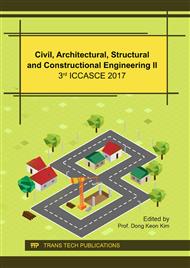[1]
WHO Air quality guidelines for particulate matter, ozone, nitrogen dioxide and sulfur dioxide (Geneva, 2006).
Google Scholar
[2]
Health effects of particulate matter. Policy implications for countries in eastern Europe, Caucasus and central Asia (Geneva, 2013).
Google Scholar
[3]
Air quality guidelines: global update 2005. Particulate matter, ozone, nitrogen dioxide and sulfur dioxide (Copenhagen, 2006).
Google Scholar
[4]
E. Samoli et al. Acute effects of ambient particulate matter on mortality in Europe and North America: results from the APHENA Study. Envir. Health Perspect. (2008).
DOI: 10.3410/f.1123173.580304
Google Scholar
[5]
R. Beelen et al. Long-term effects of traffic-related air pollution on mortality in a Dutch cohort (NLCS-AIR Study). Envir. Health Perspect. (2008).
DOI: 10.1097/01.ede.0000276562.16678.aa
Google Scholar
[6]
D. Krewski et al. Extended follow-up and spatial analysis of the American Cancer Society linking particulate air pollution and mortality. Boston, MA, Health Effects Institute, (2009).
Google Scholar
[7]
C. A. Pope III et al. Lung cancer, cardiopulmonary mortality, and long-term exposure to fine particulate air pollution. J. Am. Med. Assoc. (2002).
DOI: 10.1001/jama.287.9.1132
Google Scholar
[8]
Exposure to air pollution (particulate matter) in outdoor air. Copenhagen. (WHO Regional Office for Europe, 2011).
Google Scholar
[9]
Technical Guidance Note M15, Version 2. (Environment Agency, July 2012).
Google Scholar
[10]
J. G. Watson, J. C. Chow, D. DuBois, M. Green, N. Frank, M. Pitchford, Guidance For Network Design and Optimum Site Exposure For PM2. 5And PM10, United States Environmental Protection Agency, (1997).
Google Scholar
[11]
N. A. H. Janssen, P. Fischer, M. Marra, C. Ameling, F. R. Cassee, Short-term effects of PM2. 5, PM10 and PM2. 5–10 on daily mortality in the Netherlands, Sci. Total Envir. (2013), pp.463-464.
DOI: 10.1016/j.scitotenv.2013.05.062
Google Scholar
[12]
Modelling of PM10 and PM2. 5 ambient concentrations in Switzerland 2000 and 2010. Swiss Agency for the Environment, Forests and Landscape SAEFL, Berne, (2003).
Google Scholar
[13]
L. J. Hagen, Fine particulates (PM10 and PM2. 5) generated by breakage of mobile aggregates during simulated wind erosion, Am. Soc. Agric. Eng. 47(1) (2004) 107-112.
DOI: 10.13031/2013.15876
Google Scholar
[14]
Mineral Fertilizer Market in 2015. RBC, Moscow, (2015).
Google Scholar
[15]
V. N. Azarov, D. P. Borovkov, A. M. Redhwan, Application of swirling flows in aspiration systems Application of swirling flows in aspiration systems, Int. Rev. Mech. Eng. 8(4) (2014) 750-753.
Google Scholar
[16]
V. N. Azarov, D. V. Lukanin, D. P. Borovkov, A. M. Redhwan, Experimental study of secondary swirling flow influence on flows structure at separation chamber inlet of dust collector with counter swirling flows, Int. Rev. Mech. Eng. 8(5) (2014).
DOI: 10.15866/ireme.v8i5.3455
Google Scholar
[17]
V. N. Azarov, et al., Research of Dust Content in the Earthworks Working Area, International Conference on Industrial Engineering, ICIE 2016. Proc. Eng. 150 (2016) 2008–(2012).
DOI: 10.1016/j.proeng.2016.07.282
Google Scholar
[18]
V. N. Azarov, N. V. Menzelintseva. Main Trends of Conditions Normalizing at Cement Manufacturing Plants. Int. Rev. Civil Eng. 6 (2016) 140-145.
Google Scholar
[19]
GOST 17. 2. 3. 02-78. Protection of Nature. Atmosphere. Regulations for establishing permissible emissions of harmful substances by industrial enterprise, Publishing House of Standards. Moscow, (1979).
Google Scholar
[20]
V.N. Azarov et al. Dust 1: Certificate of state registration of the computer program № 2014618468, №2014616162; appl. 26. 06. 2014, registered in Computer Program Register on 21. 08. (2014).
Google Scholar
[21]
V. N. Azarov, N. М. Sergina, The technique of microscopic particulate analysis of the composition of the dust using a personal computer (PC). Dep. in VINITI №1332- 8000, (2002).
Google Scholar
[22]
V. N. Azarov, V. Yu. Yurkyan, N. М. Sergina, А. V. Kovaleva, The technique of microscopic particulate analysis of the composition of the dust using a personal computer (PC). Leg. Appl. Metrol. 1 (2004) 46-48.
Google Scholar
[23]
V. N. Azarov, et al. Monitoring of Fine Particulate Air Pollution as a Factor in Urban Planning Decisions, International Conference on Industrial Engineering, ICIE 2016. Proc. Eng. 150 (2016) 2001–(2007).
DOI: 10.1016/j.proeng.2016.07.279
Google Scholar
[24]
V. N. Azarov, N. A. Marinin, V. I. Burba. Assessment of PM[10] and PM[2,5] dust concentration by dissection method. Proceeding of Ecological geology: theory, practice and regional problems. 2nd Intern. Sci. -Pract. Conf., Voronezh. (2011), pp. 285-287.
Google Scholar
[25]
V. N. Azarov, I. N. Logachev, K. I. Logachev et al. Methods of reducing the power requirements of ventilation systems Part 4. Theoretical prerequisites with swirling air flows. Refract. Ind. Ceram. 55(4) (2014) 365-370.
DOI: 10.1007/s11148-014-9728-6
Google Scholar


